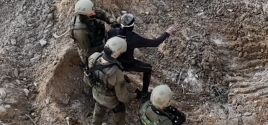Military occupation turns New Orleans into war zoneFinancial TimesSep. 07, 2005 |
Popular 
Video Shows Israeli Soldiers 'Using Palestinian as a Human Shield'

BlackRock CEO: 'Xenophobic' Countries With Shrinking Populations May Be The 'Big Winners' in AI-Driven Future

"We Were There First and Foremost for Our Country of Israel," UNC Frat Bro Tells Fox News

Report: Daily Wire Got Secret Gag Order Against Candace Owens 'While Publicly Negotiating a Debate'

House Passes 'Antisemitism Awareness Act' to Silence Criticism of Israel as Hate Speech
 New Orleans is under military occupation as well as underwater, and people wave in delight at the huge convoys of troops rumbling by, some of their vehicles in desert camouflage either back from or on their way to Iraq. As in a war zone, military bases are being established in a city divided into sectors, while the navy has moved warships up the Mississippi for helicopter operations. Martial law and curfews are in force. This, with the arrival of thousands of troops a week after Hurricane Katrina submerged large areas that were below sea level, has heartened intensely angry residents who were living in the chaos of mass destruction and the fear of looters and criminal gangs. Yet despite the enormous influx from across the US of National Guards, reservists, units of the federal army and marines, the coastguard, airmen, firefighters from Los Angeles and even Texas game wardens in boats, the logistics of evacuating the remaining residents from the flooded suburbs, and collecting possibly thousands of bodies, present enormous challenges. They also expose flaws in management structure and communications. One small cog in the biggest US relief operation is Jessie Burrell, driver of a truck carrying 51,840 bottles of water. Dispatched from Orange Springs in Florida on Saturday, he could be seen late on Monday in the upper 9th ward parked by the roadside looking at a bridge he could not cross. His typed instructions, from the Federal Emergency Management Agency (Fema), were to deliver his cargo to an address in Chalmette, an eastern suburb. But, as many people in New Orleans could have told him, and as Fema should have known, Chalmette is deep underwater. In front of him lay the Inner Harbour Navigation Canal that connects the Mississippi, running along the south of the city with Lake Pontchartrain to the north. Breaches in that canal flooded most of St Bernard parish, which includes Chalmette, to the east. At the weekend, rescue workers had towed their boats across over the St Claude Avenue Bridge to launch them on the other side of the steep levees. But then the drawbridge was raised to let barges through to start fixing the breaches and up it remained, stranding the military and Mr Burrell on the western side, unable to cross the only access point into St Bernard. Army engineers were trying to work out whether they could lower the bridge again, and if so, whether they would be able to raise it once more to let the levee work resume. Meanwhile, those managing to emerge from St Bernard say that thousands of people are still waiting to be rescued. Precisely how many thousands remains unclear. Senior officials have issued conflicting statements about the numbers of people still trapped in their homes, dead or alive. Some estimates appear completely adrift from reality. Colonel Terry Ebbert, director of the New Orleans office of Homeland Security, was quoted in the New York Times on Monday as saying that he thought there were fewer than 1,000 residents left in the city and that nearly everyone should be out by Tuesday. News Agencies quoted a deputy mayor as saying 10,000 were left. Grant Jones, an emergency co-ordinator for amateur radio operators, believes 20,000 people stayed behind in St Bernard, either ignoring the evacuation order on the eve of Katrina or simply unable to flee in time. He described how the force of the storm-surge from the lake pushed a 400-tonne barge over a levee and ploughed it through a street of houses. “They had only seconds to get out,” he said. Ferries on the Mississippi were also picked up and swept over the high banks. Even on the western side of the St Claude Avenue bridge, Major Scott Pons, of the 41st Infantry Brigade from Oregon, says he had heard estimates that 20,000 to 30,000 people remained in his sector, which mostly covers upper 9th ward. Many want to stay, while others are still waiting to be moved out. Maj Pons’s unit established its camp on Monday in the grounds of a convent. Some of the 140 soldiers have served in Iraq. Major Pons, a National Guard reservist who works as a high school teacher, is bound for Afghanistan next spring. Murky waters strewn with debris lap the streets a block away. The avenue was nicknamed “looters’ row” after the hurricane and remnants of booty lie scattered about. Dogs locked up in abandoned homes bark to be rescued. A few people in this poor neighbourhood, blacks and whites, sit on their porches and watch the military watch the unmoving bridge with its raised ramp. With the permission of the local bus company, the resourceful major has commandeered four abandoned buses that with a fleet of city police cars were raced up and down the avenue by looters and joy-riders in the chaotic aftermath. His orders are to help those who want to go. But confusion mounts in this former city of 1.5m people about what will happen if residents ignore instructions to evacuate the area. “At this point we have no intention of forcing people to go, but ultimately that may happen,” Maj Pons says, noting that the mayor of New Orleans, Ray Nagin, and the Louisiana state governor, Kathleen Blanco, have said they want to empty New Orleans in order to put it back on its feet. Local radio cited officials as saying that those who insist on staying behind will not continue to receive food supplies. Workers of the Salvation Army charity greeted these warnings with derision, saying they could sow panic. They insisted they would continue to distribute food and water from their mobile units to anyone who asked. As the major spoke, a convoy of the First Cavalry from Fort Hood, Texas, moved into a nearby naval support base. Maj Pons looked perplexed, explaining that their sector was south of the Mississippi and that they were on the wrong side of the river. |



